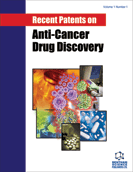Abstract
Background: The multidrug resistance (MDR) of cancer cells has become a great barrier to the success of chemotherapy.
Objective: In this study, quantitative structure activity relationship (QSAR) modeling was applied to 46 1,4-dihydropyridine structures (DHPs), and some selected compounds were docked. Methods: QSAR was used to generate models and predict the MDR inhibitory activity for a series of 1,4-dihydropyridines (DHP). The DHPs were built and optimized using the Sybyl program (x1.2 version). Descriptor generation was done by DRAGON package. Docking was carried out using Auto Dock 4.2 software. Multiple linear regression, and partial least square were performed as QSAR modelgeneration methods. External validation, cross-validation (leave one out) and y-randomization were used as validation methods. Results: The constructed model using stepwise-MLR and GA-PLS revealed good statistical parameters. In the final step all compounds were divided into two parts: symmetric (PLS) and asymmetric (MLR) 1,4-dihydropyridines and two other models were built. The square correlation coefficient (R2) and root mean square error (RMSE) for train set for GA-PLS were (R2 = 0.734, RMSE train = 0.26). Conclusion: The predictive ability of the models was found to be satisfactory and could be employed for designing new 1,4-dihydropyridines as potent MDR inhibitors in cancer treatment. 1,4- Dihydropyridine ring containing protonable nitrogen as scaffold could be proposed. Sulfur, ester, amide, acyle, ether, fragments are connected to a 1,4-dihydropyridine ring. Phenyl groups (with an electronegative substituent) as a lipophilic part are essential for the inhibitory effect.Keywords: ATP binding cassette, dihydropyridine, docking, P-glycoprotein, multidrug resistance, QSAR.
Recent Patents on Anti-Cancer Drug Discovery
Title:Docking and QSAR Studies of 1,4-Dihydropyridine Derivatives as Anti- Cancer Agent
Volume: 12 Issue: 2
Author(s): Shirin Mollazadeh, Jamal Shamsara, Maryam Iman*Farzin Hadizadeh*
Affiliation:
- Chemical Injuries Research Center, Baqiyatallah University of Medical Sciences, Tehran,Iran
- Department of Medicinal Chemistry, School of Pharmacy, Mashhad University of Medical Sciences, P.O.Box 91775-1365, Mashhad,Iran
Keywords: ATP binding cassette, dihydropyridine, docking, P-glycoprotein, multidrug resistance, QSAR.
Abstract: Background: The multidrug resistance (MDR) of cancer cells has become a great barrier to the success of chemotherapy.
Objective: In this study, quantitative structure activity relationship (QSAR) modeling was applied to 46 1,4-dihydropyridine structures (DHPs), and some selected compounds were docked. Methods: QSAR was used to generate models and predict the MDR inhibitory activity for a series of 1,4-dihydropyridines (DHP). The DHPs were built and optimized using the Sybyl program (x1.2 version). Descriptor generation was done by DRAGON package. Docking was carried out using Auto Dock 4.2 software. Multiple linear regression, and partial least square were performed as QSAR modelgeneration methods. External validation, cross-validation (leave one out) and y-randomization were used as validation methods. Results: The constructed model using stepwise-MLR and GA-PLS revealed good statistical parameters. In the final step all compounds were divided into two parts: symmetric (PLS) and asymmetric (MLR) 1,4-dihydropyridines and two other models were built. The square correlation coefficient (R2) and root mean square error (RMSE) for train set for GA-PLS were (R2 = 0.734, RMSE train = 0.26). Conclusion: The predictive ability of the models was found to be satisfactory and could be employed for designing new 1,4-dihydropyridines as potent MDR inhibitors in cancer treatment. 1,4- Dihydropyridine ring containing protonable nitrogen as scaffold could be proposed. Sulfur, ester, amide, acyle, ether, fragments are connected to a 1,4-dihydropyridine ring. Phenyl groups (with an electronegative substituent) as a lipophilic part are essential for the inhibitory effect.Export Options
About this article
Cite this article as:
Mollazadeh Shirin, Shamsara Jamal, Iman Maryam*, Hadizadeh Farzin*, Docking and QSAR Studies of 1,4-Dihydropyridine Derivatives as Anti- Cancer Agent, Recent Patents on Anti-Cancer Drug Discovery 2017; 12 (2) . https://dx.doi.org/10.2174/1574892812666170126162521
| DOI https://dx.doi.org/10.2174/1574892812666170126162521 |
Print ISSN 1574-8928 |
| Publisher Name Bentham Science Publisher |
Online ISSN 2212-3970 |
Related Books
 55
55 3
3 1
1
- Author Guidelines
- Bentham Author Support Services (BASS)
- Graphical Abstracts
- Fabricating and Stating False Information
- Research Misconduct
- Post Publication Discussions and Corrections
- Publishing Ethics and Rectitude
- Increase Visibility of Your Article
- Archiving Policies
- Peer Review Workflow
- Order Your Article Before Print
- Promote Your Article
- Manuscript Transfer Facility
- Editorial Policies
- Allegations from Whistleblowers
Related Articles
-
Monitoring the Switch: The Warburg Effect and Targeted Proteomic Analysis of Cancer Metabolism
Current Proteomics Cellular Signaling Crosstalk Between Multiple Receptors for Investigation of Pathophysiology in Multifactorial Diseases - What is Clinically-Relevant Crosstalk?
Current Medicinal Chemistry Fragment-Based Optimization of Small Molecule CXCL12 Inhibitors for Antagonizing the CXCL12/CXCR4 Interaction
Current Topics in Medicinal Chemistry Cardiac (myo)fibroblast: Novel Strategies for its Targeting Following Myocardial Infarction
Current Pharmaceutical Design MicroRNAs-based Therapy: A Novel and Promising Strategy for Cancer Treatment
MicroRNA Inflammatory Bowel Disease: New Therapeutic Options in the Post Anti-TNFα Era
Current Drug Metabolism Two Key Challenges for Effective Adenovirus-Mediated Liver Gene Therapy:Innate Immune Responses and Hepatocyte-Specific Transduction
Current Gene Therapy Platinum Complexes as Anticancer Agents
Recent Patents on Anti-Cancer Drug Discovery Structural Findings and Molecular Modeling Approach of a TFPI-Like Inhibitor
Protein & Peptide Letters Editorial [ Apoptotic Pathways as Targets for Therapeutic Intervention Guest Editor: Domagoj Vucic ]
Current Cancer Drug Targets Therapeutical Potential of CB<sub>2</sub> Receptors in Immune-Related Diseases
Current Molecular Pharmacology Graphical Abstracts
Letters in Drug Design & Discovery CXCR4 Receptor as a Promising Target for Oncolytic Drugs
Mini-Reviews in Medicinal Chemistry Caffeine and Suicide: A Systematic Review
CNS & Neurological Disorders - Drug Targets Green Chemistry Approach as a Versatile Platform for Nanoparticles with Biomedical Applications
Nanoscience & Nanotechnology-Asia FOXO and FOXM1 in Cancer: The FOXO-FOXM1 Axis Shapes the Outcome of Cancer Chemotherapy
Current Drug Targets Enzymatic and Inhibition Mechanism of Human Aromatase (CYP19A1) Enzyme. A Computational Perspective from QM/MM and Classical Molecular Dynamics Simulations
Mini-Reviews in Medicinal Chemistry Uncertainty in the Translation of Preclinical Experiments to Clinical Trials. Why do Most Phase III Clinical Trials Fail?
Current Gene Therapy Opioids and the Blood-Brain Barrier: A Dynamic Interaction with Consequences on Drug Disposition in Brain
Current Neuropharmacology Assessment of the Impact of Flavoring on the Nutritional Content of Potato Chips
Current Nutrition & Food Science


























